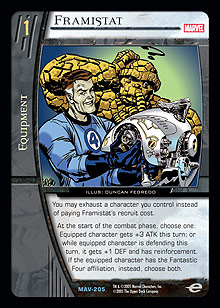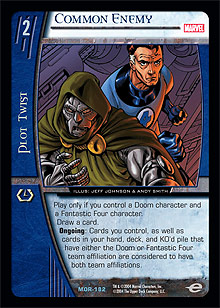
Equipment gets a bad rap. While one could argue that, over the course of a game, Dual Sidearms can earn more than just the +5 ATK a single Savage Beatdown nets you, it’s no secret which one sees more play. Plot twists have some inherent advantages over equipment, including the following:
1) Equipment cards potentially can survive on the field for many turns. Thus, they are usually less powerful than plot twist equivalents. This keeps them from being broken. Sadly, it usually keeps them from having short-term impact.
2) Plot twists don’t sit face-up next to their target character before you play them. An opponent can see equipment coming before the combat phase but cannot predict the possibility of plot twists.
3) Plot twists have a little silver number in their upper right hand corner, while equipment cards have gold numbers. This is bad. See, silver numbers are added to cards by Santa Claus, but gold numbers are added by the Poverty Demon. His job is to make gamers sad.
He does it well, too. Say what you will about demons, but they take their work seriously. The real reason most equipment cards see play only rarely is because most of the notable ones cost you a finite commodity to use. Whether you play a deck that tries to hit its curve or not, odds are good that you have plans for all of your resource points. Thus, you probably don’t have extra leeway for high cost equipment.
To combat this trend, those clever folks over in R&D have been doing a number of things to make equipment more playable. While one could just make equipment cards mega-powerful, such an approach would present a high risk of imbalance. Instead, we get equipment cards that can be discarded for alternate effects, like Chopping Block and Light Armor, or in Framistat’s case, an alternate means of attachment.
In case you haven’t given Framistat a careful reading lately, here’s what it looks like:

So, Framistat has a really cool pair of effects, and you can get around its recruit cost by exhausting a character. It’s a really interesting card for several reasons, but the first one that I’d like to discuss is the alternate attachment cost.
In short, Framistat accomplishes two general functions. First up, it adds either defensive or offensive beefiness to a single character for multiple turns at the cost of an exhaustion. Second, it can fill your curve any time you miss your turn-drop by 1 point. To explain, the average ATK of a 4-drop is 7 or 8. The average ATK of a 3-drop is 4 or 5. Thus, if all you have is an additional 3-drop on turn 4, you can spend that extra resource point to give your 3-drop Framistat. Suddenly, that character has enough firepower to duke it out with the status quo. That’s easy enough to understand, but it’s really the alternate cost option that makes this card powerful.
Flat out, when you don’t control the initiative, you’ll probably have reduced offensive options—someone’s going down, and it’s often very easy to tell who. Where Framistat moves from “kinda cool” to flat out awesome is when your opponent controls the initiative for the turn and has telegraphed an obvious attack target. You can then begin your build, play your resource, recruit characters, and exhaust the one wearing the most obvious bull’s-eye to give somebody the Fram’. You’ve basically lost nothing (as long as the opponent takes down the character you believed he or she would), and you get a permanent curve-jumping and reinforcing machine.
Even if there isn’t an obvious target that your opponent keeps leering at, go ahead and exhaust a character that is likely to provide reinforcement and equip Framistat anyway. If that character only had one option for reinforcement, great—you’ve again lost nothing. If you did just give up a reinforcement option, you’ve taken a potential loss, but in return you get a reinforcement that can’t be disrupted by formation manipulation. You also get a big attack back on the next turn. That can be a pretty sweet tradeoff.
How I Adore Duplicity
Obviously, Framistat is great when attached to a Fantastic Four character. What’s neat, though, is how it acts when it’s being used elsewhere. Framistat puts your opponent into a difficult position, because while he or she will see Framistat on the table before combat begins (often before the build), the opponent always has to settle on a formation before you choose which effect you’ll be invoking. While this sometimes won’t matter one iota, oftentimes that extra reinforcement, extra point of DEF, or potential stun back can really screw up your opponent’s plans.
Framistat actually overcomes one of the cardinal problems that inhibit the playability of equipment: it has a surprise factor built in. Options are always good, and here, those options happen to overcome one of the key challenges that equipment faces.
Sticking Up For the Little Guy
Another nice thing about Framistat is that it gives easy access to reinforcement in decks that often wouldn’t have it in the early game. Say you’re playing a typical curve deck that starts with cost-2 characters and proceeds from there. Put that deck against an aggressive New Brotherhood or Faces of Evil build, and it gets mauled on turns 1 and 2. Say it misses its drop on turn 2, or it’s a team-up deck that can’t yet share affiliations; it again gets mauled by breakthrough-laden attacks on turn 3. Even if you do have two affiliation-matched characters on turn 3, you can still only reinforce one.
Framistat can save a huge amount of endurance in this type of Curve vs. Swarm matchup, and paying the exhaustion cost is a really easy matter. One single character versus a horde of Brotherhood is pretty much a wash anyway, so you probably don’t need to feel bad about losing your chance at an attack back.
 This is especially true for Fantastic Four Beatdown and Common Enemy. Both get the full use out of Framistat’s effects, both aim to hit a rigid curve, and both can benefit from the early game reinforcement. Though each is a waning presence in the current Golden Age environment, Framistat could be a shot in the arm for these two well-recognized decks.
This is especially true for Fantastic Four Beatdown and Common Enemy. Both get the full use out of Framistat’s effects, both aim to hit a rigid curve, and both can benefit from the early game reinforcement. Though each is a waning presence in the current Golden Age environment, Framistat could be a shot in the arm for these two well-recognized decks.
Aside from that, it’s good in curve decks in general and especially in Gotham Knights Toys. The use of equipment feeds Barbara Gordon ◊ Batgirl’s effect, and Framistat’s ATK bonus helps to ensure that Catwoman, Selina Kyle can dish out the breakthrough she needs. Two cards for you and a discard for the opponent? Totally possible if you give the ladies a Framistat to play with. Fill your 2-drop slot with Spoiler ◊ Robin and you’ve got an exhaustion every turn. Spoiler’s evasion keeps her around for a measly 2 endurance, and your opponent can watch in horror as she nets you free Tech Upgrades and Framistats. I can hear Dylan Northrup drooling already.
While the F-Bomb probably won’t be breaking into Teen Titans, Curve Sentinels, or GLEE any time soon, it does lend significant support to some fading archetypes. It also gives equip-based decks a strong new weapon, and it really might bring Gotham Knights Toys and a few other curve-based strategies up a few tiers. If you’ve got an original curve deck plagued by weenies, or an equipment-heavy strategy that just can’t seem to come together, give Framistat a shot!
-Jason Grabher-Meyer